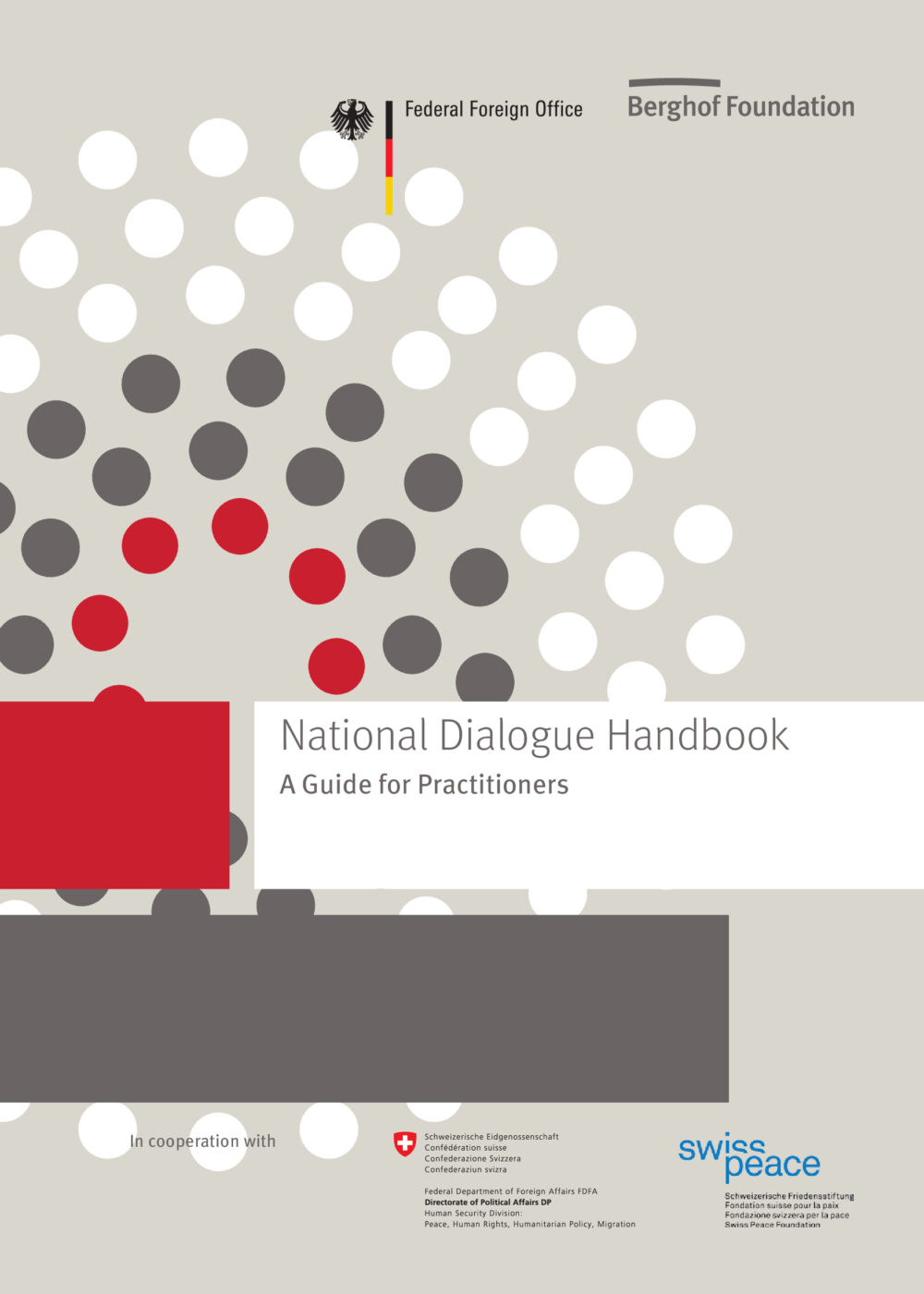BLOG POST | 10 Dec 2021
Negotiations, dialogue and mediation
Which approach leads to intra-state peace?

Read about strengths and weaknesses of each approach and how in a peace process, they can be applied in a mutually reinforcing manner.
By Hans-Joachim Giessmann
A short answer to this question would be: Most likely none alone, but possibly all together! No matter of existing deep cleavages between the parties to a conflict, all three processes rely on one prerequisite, a principled readiness to explore alternatives to the use of force to satisfy their interests.
To understand the distinct contribution of each approach and the impact of applying all three in a mutually reinforcing manner requires a closer look at their potentials and limitations.
Empirically proven, most negotiated peace agreements failed at a later stage and – instead of leading to peace after a preliminary settlement the conflicts – turned again into violence. Even more irritating, empirics seem to prove as well that victories in war seem to make sustained peace more likely than negotiations between the warring parties of a government and armed oppositions. Does that mean that in intra-state armed conflicts peace negotiations should not be the measure of choice when trying to achieve sustainable peace? Of course not! Negotiations may not be the perfect solution for achieving peace, and even less for the reconstruction of a previously broken social contract. But agreeing on some basic reliable rules for nonviolent coexistence during a transition period after a protracted war has ended, is essential for its endurance.
Negotiations are a necessary component of intra-state peace processes between two or more parties, but are not sufficient to result in peace.
Why do intra-state peace negotiations seem to fail so often?
Five reasons are of particular importance: At first, the parties to the agreements did not implement what was agreed upon. Secondly, the outcome of the negotiation was too narrow, i.e. the focus was on just ending the war, but not on paving the way to address the root causes of the conflict. Thirdly, negotiations often dominated by elites from both sides, who did not pay sufficient attention to the interests and grievances of other stakeholders, let alone the wider population. Fourthly, one or more parties considered the negotiations rather as a continuation of their war with other means. A party misused the negotiations to get an upper hand above the other. Finally, third parties often had significant influence both on the parties and on the course of negotiations, primarily along their own strategic interests, not necessarily to the benefit of conciliation between the conflict parties.
A first conclusion from these insights implies that negotiations are a necessary component of intra-state peace processes between two or more parties, but are not sufficient to result in peace. Therefore, the question is which additional or complementary approaches are most useful to make peace negotiations more effective and sustainable.
Two approaches are of particular interest: dialogue and mediation. Before delving into the details of all three approaches, a brief recap of definitions can help to understand the commonalities, overlaps and differences between the three concepts.
Definitions
Peace negotiations are mandated formats of interaction between two or more (warring) parties with opposing interests. Negotiations are limited with regard to their aims, participation, substance, and duration. They aim at a contractual agreement to the different sides’ mutual advantage in order to result in a regulated coexistence free of violence.
Peace dialogues are formats for exchange between representatives of different interest groups from across the entire spectrum of a society affected by a violent conflict. The aim of dialogues is to gain a better understanding of the underlying causes of the conflicts as well as of the different motives for the use of violence among the participants. Mutual exchange of perceptions can help to gradually develop trust and explore pathways away from violence as well as perspectives for a sustainable peaceful coexistence through joint learning and the development of ideas. Dialogues are not necessarily limited in time and scope. They can pave the way for negotiations, support them in an accompanying way, and contribute to the implementation of their results. Duration is flexible, from a day or a few days to several weeks or even months.
Peace mediation is the support of peace processes by a third party. This starts with the establishment of first contacts and lasts through different steps of negotiations. The spectrum of measures spans from supporting pro-peace actors in helping themselves through the delivery of capacity building, facilitation and provision of technical expertise for reforms of governance and government.
Potential and advantages in comparison
Negotiations, dialogue and mediation, while all serve the same purpose of building peace, follow different methods and principles. Mandate, participation, approach, organisation, and outcomes are different but they must complement one another, be mutually reinforcing, and form an integrated approach to be most effective.
Mandate
Peace negotiations usually have a clear mandate, either facilitated via a third party or agreed upon directly between the negotiating actors. They aim to generate reliable framework conditions for a long-term end to organised armed violence. In addition to the cessation of hostilities, this often requires the development of a fixed roadmap for transition towards a peaceful end state, which generally comes about through elections, a constitutional assembly, or a referendum.
Peace dialogues also tend to have a mandate, usually framed more openly and flexibly. Dialogues need a protective environment, which allows for open exchange about underlying causes of the conflict, where controversial topics can be addressed without doing harm to any participant, taking into consideration a legitimate multiplicity of interests. Through reflection and mutual learning, peace dialogues make it possible to influence behavioural patterns, attitudes and mutual relationship structures in a positive way. A written, contractual agreement is not the goal here, but rather, if at all, a declaration or a chairpersons’ statement comprising the state of consensus and differences, tentative conclusions, and ideas for the continuation of joint efforts.
Mediation efforts can result from initiatives by third actors as an offer to support constructive collaboration. However, the desire for mediation can also come from the parties directly, for instance, when they do not manage to bring about constructive negotiations or encounter an early dead-end while attempting to do so. The precondition for effective mediation is recognition of its role by all parties involved in the chosen approach. Once the former conflict parties gain the ability to resolve disputes through collaboration, the need for a third party may become obsolete. Nevertheless, a mandate for mediation can be essential also during a later phase, when the parties consider third party guarantees for the implementation of agreements to be necessary.
Participation
Peace negotiations require the participation of those actors who hold decision-making authority over the cessation of the war on their respective side. This includes having full control or command with regard to the armed forces at their disposal, and direct access to the relevant political actors on their side. Participation in peace negotiations is therefore limited to a few emissaries. Those negotiators may refer to expert support when needed, i.e. when this advice can support the resolution of disputes.
Peace dialogues offer a space for more extended participation. They allow for voices which hold no or little negotiation power but are strongly affected by the conflict and the use of force to be heard: civilian population representatives, ethnic or religious minorities, women, and others. In a dialogue, it is not delegations that interact but rather respectable representatives from different parties and societal groups. Even if mandated by those parties, they usually participate in their personal capacity. The number of participants in a peace dialogue varies between small formats with a dozen participants are possible just as are those with 5,000 or more participants in a National Dialogue.

Peace mediation aims at the direct interaction of third parties with key actors of the conflict parties. It targets those persons who hold or may hold key positions for the transition from confrontation to cooperation. This said, it leaves open the question whether the task of mediation is assigned to external third actors (states, organisations, individuals) or if proxies or personalities from within the ranks of the conflicting parties themselves represent a more acceptable option. In some conflict settings, the parties have caveats vis-à-vis external actors, because of cultural difference or due to past experiences, for example when an interested mediator represents a country, which is known for its past colonialist rule in the region.
Approach
In peace negotiations, a clear mandate and limited number of participants make it easier to manage the process and maintain a high degree of confidentiality. Strict confidentiality is required for reasons like compromise offers running against expectations back home. At the core, negotiations aim at a give and take, a deal, which comprises a sum of individual agreements as a jointly acceptable solution. Any concession, perceived by one side as a unilateral disadvantage, can indeed be necessary within the overall balance of the agreements in order to achieve an overall result desired by one’s own side as well. In this respect, the principle of “nothing is agreed until everything is agreed” (which was stated for the first time in the Northern Ireland negotiations) should apply. The recognition of this principle, however, requires strict confidentiality until the parties sign an agreement.
Confidentiality plays a similarly important role for peace dialogues as it protects the integrity of the participants. It has been common practice, to apply the so-called “Chatham House Rule” in sensitive dialogues. It stipulates that any opinions or ideas shared in the dialogue can be made public, however, not the identity of those who shared them. Peace dialogues are not secret meetings, they are somewhat a microcosm of the society, inviting all people to help shape the peace process. This aims at creating trust already throughout the process. Trust, grown through joint learning during the dialogue, contains the potential of sustained collaboration. Moreover, as a learning process, peace dialogues are the most suitable format in order to address also non-negotiable difference and deal with emotions.
Trust and confidentiality are indispensable foundations for constructive mediation. Impartiality is a minimum requirement from the mediator, more suitable is multi-partiality. This is the ability to stand by all parties to a conflict, to understand and consider all their underlying interests when searching for peaceful common solutions, without generating new tensions. Strict confidentiality when dealing with the conflict parties as well as towards the public, makes it possible for a mediator to help address the most complicated questions. Mediation, however, only has a chance to be supportive and effective, if all participating sides request mediation and accept the mediator(s).
Organisation
A reciprocal agreement on precise behavioural rules is essential for negotiations, but they can also be an advantage for dialogues and mediation processes. This includes procedural rules, which
- Address the mode of interactions between the parties,
- Support the efficiency of the negotiation process, and
- Clarify the scope of confidentiality and transparency.
Such rules help to structure the negotiation process and can form a point of reference for participants. Next to the agreement on rules, questions of support are important, such as the involvement of third parties, for example for the provision of resources, a secure negotiation venue, or guarantees for the orderly flow of negotiations.
For an effective peace dialogue, a professional facilitation is required. It helps with drafting the agenda, structures the process, enables flexible formats for exchange, and intervenes when participants don’t adhere to the agreed upon rules. The participants should accept both the role of the facilitator as well as the person who was chosen to do facilitation. The facilitator must be ready to identify the legitimate interests of all participants and give a way for their expression in a fair manner.
For mediation, it is important to consider whether a third party or the negotiating parties themselves have initiated mediation. Mediation is of course particularly useful to help peace-ready parties help themselves. Sometimes, third parties attempt to cause changes in behaviour and reorganise relationships between conflict parties. The exertion of power by a third party can be temporarily useful to break a deadlock, or decrease the influence of so-called hardliners. But if pressure turns into patronage, mediation is most likely doomed to fail. Such “peace agreements” usually only last if pressure is maintained, if the third party exerts control over the respective country or conflict party in the longer run. Yet, external pressure should not last too long.
Outcomes
Ideally, peace negotiations create a reliable partnership between the participants. Negotiations can lead to trust between the negotiators but cannot bring about trust between the parties to the conflict. In the society, only the verifiable implementation of the agreed-upon “deal” in spirit and letter can slowly produce mutual trust. Negotiations make possible measurable preconditions – a framework – for the “real” peace process, in which the parties learn through collaboration how to pursue joint or overlapping interests and how to address conflicts nonviolently.
The result of a dialogue event is often hard to capture at a glance and most of the time, it will not produce quick changes or results. Despite the fact that the experience of resolving conflicts together in a peaceful manner, which develops through joint learning, carries greater sustainability than the implementation of a “deal” about give and take. The mostly lengthy, and difficult to predict unfolding of discernible effects for the transition to peace is the biggest hurdle in gaining support for the dialogue approach in peace processes. Still, a dialogue provides a valuable space to make the participants aware of existing grievances on all sides, and can help create more empathy for others’ aspirations and concerns, and gradually building trust through listening to, and learning from, each other. A dialogue can send immediate and encouraging messages into the wider society. Dialogue can serve as a precursor to negotiations, may accompany negotiations or may support implementation of their results.
Mediation, as said earlier, is a useful tool to avoid impasses between the parties. Deadlocks are usually inevitable, but may not result in a breakdown if an experienced mediator lends a hand. However, mediation can fail because of manifold reasons. The parties may perceive the mediator as acting in a partisan manner or the mediator may lose interest in the process if the negotiations drag on for too long. The mediator may lose interest in the process if the negotiations drag on for too long without any visible progress. Mediation can also fail, when the conflict parties confuse them with partisanship for their own benefit and strive to gain the upper hand without the willingness to balance interests. This may happen during the negotiations, more often however in the aftermath, when the negotiated agreements fail the test of practice.
Peace negotiations, dialogues, and mediation possess great potential for the sustainable termination of intra-state wars. But if pursued on their own, they also carry a high risk of failure.
Conclusions
Which path leads to peace? Peace negotiations, dialogues, and mediation possess great potential for the sustainable termination of intra-state wars. But if pursued on their own, they also carry a high risk of failure. Peace negotiations are likely to fail when the parties consider them as a continuation of war by other means or if agreements do not sustain in practice. Peace dialogues can only be successful, when there is not only an exchange of positions but, based on emerging trust between the parties, interests become balanced. Finally, success or failure of a mediation depends on all actors’ openness to the prospect of peace, if third actors do not deprive negotiating parties of self-responsibility, or try to impose solutions on them.
A mutually reinforcing combination, ideally the integration, of all three approaches reduces the risks of failure. However, if the conflict parties themselves are not willing to conceive credible alternatives to war, even the smartest approach will most likely fail.
This text is based on an article published in German in S+F Sicherheit und Frieden (issue 4/2020).
Thanks to Theresa Breitmaier, Basir Feda and Charlotte Hamm for their valuable comments.
Media contact
You can reach the press team at:
+49 (0) 177 7052758
email hidden; JavaScript is required


